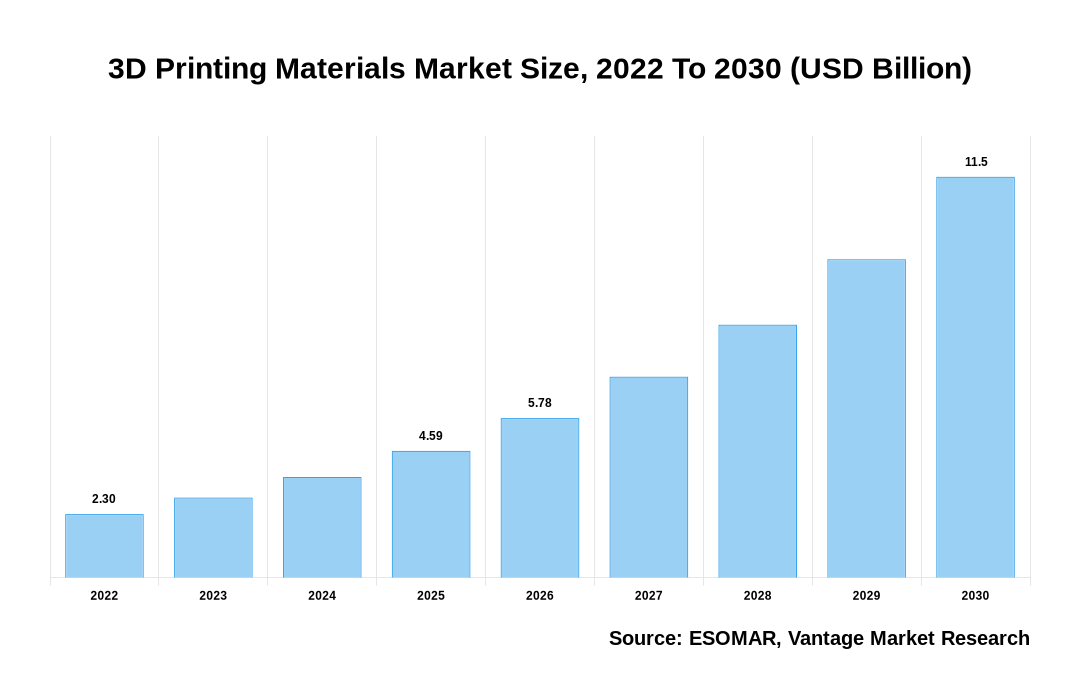Global 3D Printing Materials Market
As stated in our extensive report; the Global 3D Printing Materials Market accounted for USD 2.3 Billion in the year 2022 and is forecast to reach USD 11.53 Billion by 2030 at a CAGR of 25.9%.
To manufacture scaled models for testing, 3D Printing Materials are frequently used in the automotive industry. Bellows, front bumpers, air conditioner ducting, suspension wishbones, dashboard interfaces, brackets for installing alternators, battery covers, and other parts are also made of them. Automotive OEM producers use 3D Printing Materials for rapid prototyping. Due to its advantages, including low cost, rapid prototyping, minimal material waste, and others, 3D printing is increasingly being used by the automotive industry. These materials are used by some of the top automakers in the world, including AUDI, Rolls-Royce, Porsche, Hackrod, and many others, to create metal prototypes and replacement components. The current slump in global vehicle production has affected the market for polyester staple fibre due to the decreased demand for automotive fibres. Additionally, it is anticipated that the current decline in auto sales in countries like China will hinder the need for 3D Printing Materials. The need for 3D Printing Materials in the automotive industry, however, is anticipated to rise in the coming years.
Click To Get a Free Sample On the Research Study

The market will expand quickly due to the ongoing transition from conventional printing to 3D printing technologies. Less waste, more sophisticated designs, economic effectiveness, and improved design modification are just a few benefits of 3D printing. Furthermore, as the benefits of 3D printing technology have become more well known, businesses from a variety of industries have been drawn in. The technique is being used in the food, footwear, music, jewellery, and medical industries to produce new products more affordably. This will boost the market share of 3D Printing Materials in the next years. The market will expand quickly during the projected period as a result of the growing use of 3D-printed components in military, automotive, and aerospace applications.
There is an increasing need for 3D printing technology because it allows for mass customization, enhanced strength, less inventory, and decreased weight. The market for 3D Printing Materials is expanding as a result of the healthcare sector’s rising reliance on technology. The market for 3D Printing Materials is predicted to develop as demand for dental implants increases. Government expenditures in 3D printing projects, decreased manufacturing costs and process downtime, easier development of customised products, and the creation of new industrial-grade 3D Printing Materials are all driving the industry. Investments in 3D printing projects and the creation of brand-new, industrial-grade 3D Printing Materials are stimulating the market. Al and ML are two recent technological advancements that are helping to increase the need for 3D printing equipment. As far as preferred technology goes, selective laser sintering has been chosen.
Factors Influencing Global 3D Printing Material Market Growth
The growth of the global 3D Printing Materials market can be attributable to the following:
- Sales in the market are anticipated to increase due to the continued growth of end-use industries such automotive, medical, electronics, aerospace, and industrial. Metals suitable for 3D printing include titanium, steel, cobalt-nickel alloys, aluminum, and others. The market is anticipated to grow as a result of the significant use of these metals in numerous end-use industries. Also, it is anticipated that using metal powder in the business will reduce carbon emissions, which will increase sales in the years to come.
- The demand for 3D Printing Materials is anticipated to rise in response to a growing need from the automotive industry for the production of car interiors. Due to the lightweight nature of 3D printed parts, the overall weight of the vehicles is effectively decreased, increasing the vehicles fuel economy. For the course of the assessment period, this trend is predicted to persist.
- The world’s largest automotive market, in terms of production, is China. Despite a decline in local production in recent years, the market for electric vehicles is expected to grow. According to projections, the market under study will be driven by all of these elements as well as domestic demand.
- In addition, it is anticipated that the market would be driven by an increase in the use of ceramics for 3D printing in the creation of medical equipment. Over the projection period, increasing investments in the healthcare industry, the use of adaptive manufacturing methods, and technical breakthroughs will all continue to drive up demand for 3D Printing Materials.
- Sales in the market are anticipated to be driven by technological developments and new product innovations. The market will continue to rise in the coming years as a result of rapid industrialization in developing nations, a rising demand for print advertising, and rising investments in the healthcare sectors. The market will grow more quickly if additive manufacturing is used more often to produce a variety of industrial parts and items. In the upcoming years, it is projected that rising technological usage in North America and East Asia would increase demand for 3D Printing Materials.
North America Region to Dominate the Global Market
Due to the major hold in terms of sales in the global market for 3D Printing Materials Market, North America is anticipated to account for a dominant position in the forecast period. Many well-known players in the 3D Printing Materials business are based in this area. Local companies are introducing tailored products to satisfy customer needs. The nation is implementing 3D printing technology to build homes, businesses, and bridges. In addition, Shanghai is the location of the 176 concrete segment, 86 foot long longest 3D-printed bridge in the world. There are a number barriers to 3D printing in the construction industry, including building developers’ lack of confidence and the absence of appropriate regulations for its use. But, as people grow more knowledgeable about new technology and its advantages, businesses and people alike are resorting more and more to cost-cutting strategies. In turn, this is boosting demand in the nation’s 3D concrete printing market. China is the largest automobile market in the world in terms of output. Despite recent declines in local manufacturing, the market for electric vehicles is expected to grow. The demand in the nation and each of these elements are anticipated to drive the market under discussion.
Conclusion
The overall 3D Printing Materials Market sales have been favorably impacted by rising automotive investment and population density.
Notable and prominent players in the Global 3D Printing Materials Market include- Hogans (Sweden), 3D Systems Corporation (U.S.), General Electric (U.S.), Arkema S.A. (France), Royal DSM N.V (Netherlands), Stratasys Ltd. (U.S.), Evonik Industries AG (Germany) and others.
![[Market Research Reports] – Research Google News Blog | VMR.Biz](https://www.vmr.biz/wp-content/uploads/2022/12/logo-removebg-preview.png)











